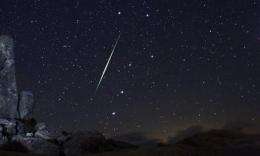Nature's coming attraction: Geminid meteor shower

(AP) -- Stay tuned for nature's coming attraction. Early next week, the Geminid meteor shower will make its annual appearance, just in time for Christmas. Astronomers consider it the best meteor shower of the year, with more than 100 meteors streaking through the night sky every hour.
The peak of the meteor shower will occur early Tuesday, between midnight and sunrise local time. The show will be best in the Northern Hemisphere, easily visible with the naked eye.
The Geminids are actually rocky celestial leftovers. Every December, Earth passes through this stream of debris from 3200 Phaethon, once believed to be an asteroid and now considered an extinct - or iceless - comet. The meteors, or shooting stars, can appear anywhere, but always seem to fall from the Gemini constellation, thus their name.
Meteors occur when bits of particles enter the atmosphere and burn up, resembling incoming fireballs.
For those not willing to stay up late - or get up early - there should be a decent showing Monday once the sun sets. Actually, some meteors should be visible in the night sky from Dec. 12 to 16, as long as the sky is clear, according to NASA.
And consider it a warm-up for the total lunar eclipse coming the night of Dec. 20 and wee hours of Dec. 21, depending on your time zone. It will be the only full lunar eclipse of the year and the entire event will be visible in North America, Central America, a bit of South America, Greenland and Iceland.
More information: NASA: http://www.nasa.gov/connect/chat/geminids2010.html
©2010 The Associated Press. All rights reserved. This material may not be published, broadcast, rewritten or redistributed.




















